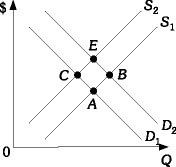Fixed costs are
A) a production expense that does not vary with output.
B) a production expense that changes with the quantity of output produced.
C) equal to total cost divided by the units of output produced.
D) the amount by which a firm's cost changes if the firm produces one more unit of output.
A
You might also like to view...
Compared to the general population, millionaires are more likely to be
a. well-educated. b. relatively old. c. self-employed. d. all of the above. e. only b and c above.
Because the government must pay interest on the public debt, its ability to balance the budget or fund public sector activities is reduced.
Answer the following statement true (T) or false (F)
Which of the following is designated by points C’ and C in Exhibit 4?

a. Calvin and Wendy each benefit by specializing and trading their goods.
b. By specializing in food, Wendy can produce and trade 13 pounds of food per day.
c. In their exchange, the price of Wendy’s food is higher than the price of Calvin’s cloth.
d. Through trade, Wendy’s food production drops from 10 pounds to 7 pounds per day.
Refer to the information provided in Figure 3.16 below to answer the question(s) that follow. Figure 3.16Refer to Figure 3.16. When the economy moves from Point E to Point B, there has been
Figure 3.16Refer to Figure 3.16. When the economy moves from Point E to Point B, there has been
A. a decrease in supply and an increase in quantity demanded. B. a decrease in supply and an increase in demand. C. an increase in supply and an increase in quantity demanded. D. an increase in both supply and demand.